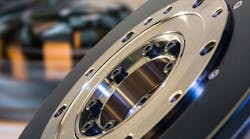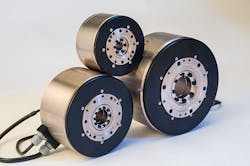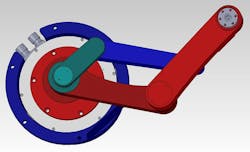The changing face of manufacturing is forcing businesses to rethink their technology and infrastructure investments. In fact, a recent article in Material Handling & Logistics highlighted how the entire supply chain is poised for a transformation as e-commerce and other innovations, such as robotics and the Internet of Things, become more prevalent.
Packaging is one area where manufacturers can expect significant changes, where technologies, such as "laser sensors and weighing scales can quickly determine the correct size needed for an item and then cutting machines prepare the exact sized box," said Al Will, retired Marine Colonel, logistics specialist, and president of PWG Distribution Solutions, to MH&L.
Many of these technologies require motors that can enable more efficient and reliable operation. Direct-drive motors can help increase productivity and minimize maintenance-related downtime on various assembly and packaging applications.
NED recently spoke with Bryan Knight, product marketing manager at Yaskawa America Inc.'s motion division to learn more about the potential benefits of direct-drive rotary servo motors.
NED: What are the primary advantages of direct-drive motors?
Knight: Direct-drive motors give you higher torque and lower speed compared to a traditional rotary servo motor. What this allows you to do is mount the load directly to the motor without using gear reduction. For example, a typical servo motor that can run at maybe 6,000 rpm, which is too high for most applications, requires a gearhead to reduce the speed and gain torque. But when you use a direct-drive rotary style servo motor, the high pole count gives you that high torque. This allows you to reduce the servo motor and gearbox combination down to a single component that is directly driving the application, so you eliminate all the mechanical components that introduce backlash, resonance and positioning error.
NED: Your direct-drive motors use a 24-bit encoder. Can you please explain the significance of this and why it's important?
Knight: Because the 24-bit encoder is directly coupled to the rotor and the load, the accuracy of the machine comes down to the accuracy of the encoder, whereas with a traditional rotary servo motor, the encoder in the servo motor is measuring only the position of the servo motor. Any backlash or play in the mechanical transmission creates inaccuracy.
NED: What are some of the applications that these motors typically handle?
Knight: One of the typical applications would be a rotary indexing table. That's a system where you turn an assembly line into a circle. It acts as a continuous, progressive assembly line. The key with a rotary indexing table is that you need to align it precisely with the equipment – whether it's a robot or an air cylinder or a printer or some other device that's acting on the part. If you're using a direct-drive motor, the encoder feedback tells you exactly where the load is, since it is directly coupled. This ensures there's no mechanical loss. But if you used a gearbox mechanism, as the gearbox wears you start to lose some of your accuracy. Also, if there's a reason you want to skip a station or change the number of steps in a process, you can easily change that in your motion program. However, with some of these mechanical indexing gearbox solutions, they're designed to have a certain number of stations in them, so changing those stations would require physically changing out the gearbox.
NED: Are there any other applications that are ideal for direct-drive motors?
Knight: Another would be a robotic arm called a four-bar robot, which uses a pair of direct-drive rotary servo motors. Because the direct-drive rotary servo motor has a hollow bore through it, you can run two shafts coaxially -- one connected to the first motor and one connected to the second motor. This allows you to create a two-axis robot that doesn't have any motor mass on the arms, so it's a lightweight mechanism that can move very fast and gives you high repeatability. It's often used to work on things like assembly parts and semiconductor or glass components. And, again, because you're directly coupled to the motor without gearboxes, there's no wear components involved in the transmission, so it has very high accuracy and high rigidity of the system.
NED: It sounds like there would be some maintenance advantages to a direct-drive motor because of fewer moving parts. Is that correct?
Knight: Yes. Definitely. From a maintenance and reliability standpoint, you only have the rotor as the only moving part in the entire system. The table or the arm or whatever mechanism you're bolting to it is bolted directly to that rotor with no components in between. For example, a gearbox requires periodic lubrication, and you have ensure that couplings are not loosened or belts aren't stretching or changing with temperature or age. Those are maintenance items that are eliminated when using a direct-drive servo motor.
NED: Are there particular industries that are well-suited for direct-drive motors?
Knight: The major ones are going to be packaging and assembly. In packaging there are a lot of custom-based robotics systems. People are now starting to integrate motors into their own custom robotics systems, and these motors are ideally suited for those types of systems because robotic actuators require low speeds with high torque and rigidity, and minimal overshoot and settling time. The traditional approach to achieve lower speeds has been to use a planetary or strain wave gearbox, and this eliminates this entirely.
NED: How do these motors help improve plant-floor efficiency?
Knight: Every time you add a mechanical component, you're going to have some loss of efficiency, so even the best planetary gearboxes are typically 96% efficient. Adding a belt-drive system adds further inefficiencies, so any time you can reduce the number of mechanical components in the system your efficiency is improved. That efficiency translates directly to energy savings.
NED: How about space savings? I imagine with fewer parts you're also minimizing space requirements.
Knight: Space savings is pretty important because if you can convert a motor and gearbox into just a small flat cylinder-shaped motor, that smaller packaging allows you to get all of the additional components in the machine closer to the process. This means you may be able to use a shorter-reach robot or a shorter-stroke linear actuator or shorter air cylinders. All processes become more compact, and you if shorten the strokes on all of the other components that means better efficiencies as well – including shorter cycle times, better accuracy and more energy efficiency.














